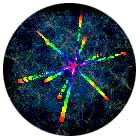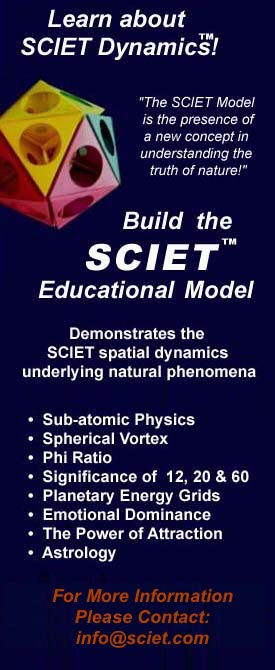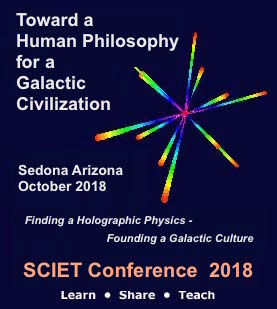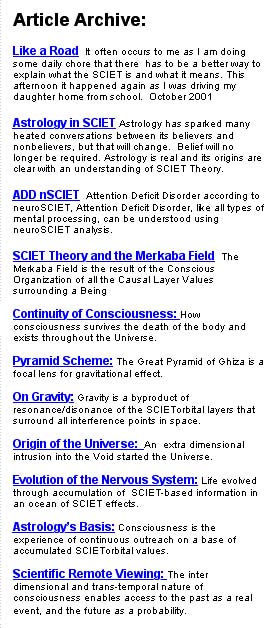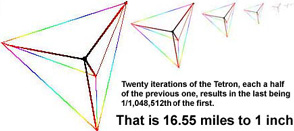|
|
 |
 |
 |
 |
|
 |
|
|
|
|
|
|
|
SCIET Awareness
Harmonic Fractional Receptive Reduction
At the beginning of each and every cycle the outreach establishes a match and linear relationship between the center and the edge that subdivides into equidistant parts until it reaches a value equal to the minimum originating part.
The Stages of Creation
SCIET Awareness
|
|
The key to doing this is the SCIET, a kind of mathematical atom. It defines a process within a specific space that begins with an act of awareness, the recognition that there is another place or point in space. The simple act of awareness is the beginning of the universe. Using the SCIET we can build a model of change that replicates creation.
The act of awareness can be described by a line drawn between two points, followed by a series of other lines based on the first one, each originating from the same point until all the space surrounding that point is defined by the first line and its parts. The lines between the lines are also based on the original base line or SCIET Line. All points in space do this. All that is required is for them to be defined through relationship to something else that exists.
The first stage of creation defines all the space relative to a central point, followed by all defined points reacting to each other in a continuous reaction of creation.Each cycle begins by defining a new value that is subdevided into the space surrounding the center and as it subdivides into equal parts does so in a manner that allows each point to maintain its own identity, to have a unique but harmonic part in the whole at all times.
Another way to look at it is to imagine that the smallest center point of the SCIET is a pixel, in which case the computer display would need to be 1214 feet by 1214 feet square. This is a SCIET Magnitude. |
|
The SCIET is derived from the tetrahedral form because it is able to define space using a single value away from the center, but it is also true that any affect would stimulate the SCIET into existanc becaue it is the default fracture pattern of the Creation Substance
The SCIET Line creates a starting set of four equidistant points that then react to one another to create the stable form of the SCIET, which is the mathematical atom. It represents three levels of harmonic space reacting to itself. Each tetrahedral form (Tetron) has two levels and the grouping of them into a SCIET of twenty creates a third level harmonic that is stable
Subdivision in space is a primary assumption in SCIET Dynamics. The tetrons each defining a distance from the center in two ways, the edge and center.
The Capacitance Lattice originates with the SCIET Orbital Return from all the matter in direct line-of-sight. SCIET Spheres are the result of the orbital return, with the smallest fastest frequencies creating proton shells and the proton shells themselves providing the orbital return that creates electrons. |
|
While resonance insists upon the even subdivision of space the growth of living bodies uses the phi ratio.
The role of Phi in the subdivision of space and nature
In SCIET Theory the Phi ratio is seen in the tetron as part of the SCIET. The angle of the SCIET center to the tetron center creates a phi relationship between the surface planes of the Icosahedral and Dodecahedral forms.
The three forms above illustrate the origin of the Phi ratio in nature. Each SCIET contains a series of resonant points defined approximately by the tetron resonance. On the left is a diagram of the Phi ratio as it originates in the tetron. and on the right is the Icosahedral structure of the twenty tetrons together on a central point with the Dodecahedral form created by connecting their midpoints |
|
The occurrence of the Phi ratio in nature suggests that living organisms rely on SCIET resonance to unify their systems during growth from a starting point of a single cell. This also suggests that life uses the SCIET as the underlying pattern for the synthesis and integration of information during life processes.
|
|
|
|
|
Please contact our Webmaster with questions or comments
Copyright 1995-2013© Dane Michael Arr |
|
|
|
|
